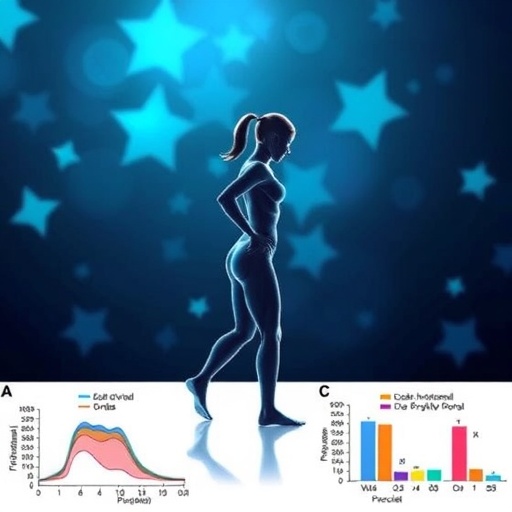
In a groundbreaking study poised to redefine our understanding of muscular health in aging women, scientists have uncovered the pivotal role of two proteins—growth differentiation factor 8 (GDF8) and activin A—in regulating muscle mass among postmenopausal females. This revelation, emerging from a carefully controlled randomized phase I clinical trial, promises to open new avenues for therapeutic intervention targeting muscle wasting, a condition that afflicts millions and profoundly impacts quality of life in this demographic.
Muscle mass naturally declines with age, a phenomenon known as sarcopenia, which significantly accelerates in women following menopause due to hormonal changes. The intricate molecular mechanisms governing this process have remained elusive, hindering effective treatments. However, the recent findings published in Nature Communications illuminate the suppressive influence of GDF8 and activin A on muscle anabolism in postmenopausal women, marking a major leap in the field of geriatric muscle biology.
GDF8, also widely known as myostatin, belongs to the transforming growth factor-beta (TGF-β) superfamily and has long been recognized in animal models as a negative regulator of muscle growth. Activin A, another TGF-β ligand, has similarly been implicated in diverse biological processes including inflammation and cellular differentiation. The novel clinical investigation led by Gonzalez Trotter and colleagues meticulously quantified the levels of these proteins and assessed their functional impact through a pharmaceutical blockade in human subjects, a pioneering step beyond prior in vitro and animal research.
The randomized phase I trial administered antagonists targeting GDF8 and activin A in postmenopausal women, monitoring changes in muscle mass, strength, and biochemical markers. The use of selective inhibitors allowed the researchers to dissect the individual and combined effects of these ligands on muscle physiology. Results demonstrated a marked increase in muscle volume and improved functional metrics upon suppression of these proteins, highlighting their direct inhibitory role on muscle growth pathways that intensify following menopause.
Mechanistically, GDF8 and activin A exert their influence through signaling cascades involving the activin receptor type II, which activates intracellular SMAD proteins to repress muscle cell hypertrophy. By interfering with this pathway, the antagonists effectively lifted the molecular brakes on protein synthesis and satellite cell activation—the essential processes for muscle repair and regeneration. This intervention reverses atrophy-inducing signals long believed to be non-modifiable in postmenopausal women.
The trial’s rigorous design included extensive biomarker analyses to correlate ligand concentrations with muscle outcomes and systemic physiological changes. Notably, the blockade of GDF8 and activin A led to the restoration of anabolic signaling via the mTOR pathway, a master regulator of cell growth and protein synthesis. This molecular rejuvenation translates clinically into enhanced physical capabilities and presents a promising strategy to combat sarcopenia and frailty.
While muscle mass decline is often attributed to hormonal shifts such as estrogen deficiency post-menopause, these findings underscore the centrality of GDF8 and activin A as negative regulators operating downstream or independently of sex hormones. This insight widens the therapeutic landscape, suggesting that treatments targeting these ligands may provide benefits beyond hormone replacement therapies, which carry significant risks and contraindications.
The implications of these discoveries extend into metabolic health as well. Skeletal muscle is a key site for glucose uptake and insulin sensitivity; thus, preserving or augmenting muscle mass has potential to mitigate metabolic disorders commonly escalating after menopause, including type 2 diabetes and obesity. This systemic perspective amplifies the clinical importance of modulating GDF8 and activin A activity.
Importantly, the safety profile observed in this phase I trial suggests that selective antagonism of GDF8 and activin A is well tolerated, a critical consideration for elderly patients often burdened with comorbidities. Future trials will need to probe long-term effects, dosage optimization, and efficacy across diverse populations to fully harness the therapeutic potential highlighted by this initial study.
The pioneering work also opens intriguing biological questions about the role of these ligands in muscle dynamics under different physiological conditions. For example, how do varying levels of GDF8 and activin A interact with exercise, nutrition, and other hormonal signals to modulate muscle phenotype? Unraveling these complex interactions could optimize personalized interventions for muscle preservation.
The research community has long sought effective remedies for muscle wasting in older adults, a condition linked to increased morbidity, falls, and reduced independence. By identifying GDF8 and activin A as key molecular gatekeepers, this study provides a targeted focus for drug development and clinical innovation that could dramatically improve patient outcomes and reduce healthcare burdens.
Emerging therapies based on these findings might include monoclonal antibodies, receptor decoys, or small-molecule inhibitors designed to disrupt the GDF8/activin A signaling axis specifically in skeletal muscle tissue. Such precision medicine approaches could minimize side effects and maximize efficacy compared to broader systemic treatments.
Moreover, the study underscores the importance of integrating molecular biology with clinical research to translate bench discoveries into effective patient care. The use of a randomized clinical trial framework establishes a high standard of evidence, essential for regulatory approval and widespread adoption of novel interventions.
Looking ahead, the intersection of aging biology, endocrinology, and muscle physiology illuminated by this work invites multidisciplinary collaborations. By combining expertise in these fields, future research can refine therapeutic strategies, explore combinatory regimens with exercise and nutrition, and advance biomarker-driven approaches for early diagnosis and intervention.
In summary, the discovery of GDF8 and activin A as dominant negative regulators of muscle mass in postmenopausal females reshapes our understanding of muscle wasting and offers a beacon of hope for millions confronting the physical declines of aging. This landmark trial spearheaded by Gonzalez Trotter and colleagues not only demystifies key molecular players but also charts a promising path toward transformative treatments that restore strength, function, and vitality in aging women worldwide.
Subject of Research: The role of GDF8 and activin A as negative regulators of muscle mass in postmenopausal females.
Article Title: GDF8 and activin A are the key negative regulators of muscle mass in postmenopausal females: a randomized phase I trial.
Article References:
Gonzalez Trotter, D., Donahue, S., Wynne, C. et al. GDF8 and activin A are the key negative regulators of muscle mass in postmenopausal females: a randomized phase I trial. Nat Commun 16, 4376 (2025). https://doi.org/10.1038/s41467-025-59380-3
Image Credits: AI Generated
Tags: Activin A muscle regulationGDF8 protein functiongroundbreaking studies in muscle researchhormonal changes and muscle lossmolecular mechanisms of muscle anabolismmuscle mass decline factorspostmenopausal muscle healthquality of life in postmenopausal womenrandomized clinical trials in geriatricssarcopenia in aging womenTGF-beta superfamily in muscle biologytherapeutic interventions for muscle wasting





